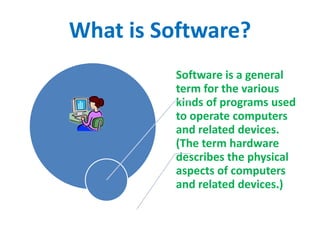Defining Software and Its Crucial Role
At its core, software refers to a set of instructions that enable a computer to perform specific tasks. From the operating system that powers your device to the applications that simplify your daily activities, software is the digital architect shaping our interactions with technology.
Types of Software: Unveiling the Layers of Functionality
System Software
System software manages hardware components, ensuring seamless communication between the user and the computer. Operating systems like Windows, macOS, and Linux fall under this category.
Application Software
Application software caters to user-specific needs, ranging from word processors to graphic design tools. Examples include Microsoft Office, Adobe Creative Suite, and video games.
Programming Software
Developers rely on programming software to write, test, and debug code. Integrated Development Environments (IDEs) like Visual Studio and Eclipse facilitate this intricate process.
How Software Works: Peering into the Digital Alchemy
Software operates through a meticulous code execution process. This involves translating high-level programming languages into machine code, facilitating smooth interactions between the software and hardware components.
Evolution of Software: From Binary Code to Limitless Possibilities
In the early days of computing, programmers communicated directly in binary code. As technology progressed, assembly languages and higher-level programming languages emerged, revolutionizing software development. Today, languages like Python, Java, and C++ dominate the coding landscape.
Common Software Technologies: Navigating the Technological Frontier
Artificial Intelligence
AI empowers machines to mimic human intelligence, leading to innovations like voice assistants, recommendation systems, and autonomous vehicles.
Augmented Reality/Virtual Reality (AR/VR)
AR/VR technologies create immersive experiences, transforming industries like gaming, education, and healthcare.
Cloud Computing
Cloud computing revolutionizes data storage and processing, offering scalable solutions to individuals and businesses alike.
Impact of Software on Industries: Transformative Forces at Work
Healthcare
softwarechiefs.com/ enhances medical diagnostics, facilitates telemedicine, and streamlines patient records, leading to improved healthcare outcomes.
Finance
Financial institutions leverage software for secure transactions, algorithmic trading, and fraud detection, ensuring the integrity of the global financial system.
Education
Educational software enhances learning experiences through interactive lessons, online courses, and personalized tutoring.
Challenges in Software Development: Navigating the Complex Terrain
Software development grapples with security concerns, evolving technologies, and the need for constant adaptation. Safeguarding against cyber threats and ensuring compatibility with ever-changing hardware are ongoing challenges.
Future Trends in Software: Paving the Way for Innovation
Quantum Computing
Quantum computing holds the promise of unparalleled processing power, potentially revolutionizing cryptography, optimization problems, and scientific simulations.
Edge Computing
Edge computing decentralizes data processing, reducing latency and enhancing the efficiency of IoT devices.
Blockchain Technology
Blockchain ensures secure and transparent transactions, disrupting industries like finance, supply chain, and healthcare.
Importance of Quality Software: Elevating User Experience and Reliability
Quality software prioritizes user experience, ensuring intuitive interfaces and efficient functionality. Reliability is crucial, preventing system crashes, data loss, and security breaches.
Tips for Choosing the Right Software: A User’s Guide
Identifying specific needs, researching available options, and considering user reviews are essential steps in selecting the right software. A thorough evaluation ensures compatibility and functionality tailored to individual requirements.
Open Source vs. Proprietary Software: Weighing the Pros and Cons
Choosing between open source and proprietary software involves considering factors like customization, support, and licensing. While open source offers flexibility, proprietary software often comes with dedicated support and advanced features.
Software Development Life Cycle (SDLC): A Blueprint for Success
Understanding the phases of SDLC—planning, design, development, testing, deployment, and maintenance—ensures a systematic and efficient software development process.
The Role of Software in Connectivity: Linking the Digital Tapestry
Internet of Things (IoT)
IoT connects devices, allowing them to communicate and share data, leading to smart homes, cities, and industries.
Smart Devices
Software empowers smart devices, from phones to thermostats, enhancing their capabilities and connectivity.
Ethical Considerations in Software Development: Navigating the Moral Compass
Respecting user privacy, avoiding biases in AI algorithms, and implementing responsible AI practices are essential in navigating the ethical considerations of software development.
Conclusion: Decoding the Digital Symphony
In the ever-evolving landscape of technology, software stands as the silent architect, shaping our digital experiences. Its impact is profound, transforming industries, connecting the world, and propelling us into the future.

